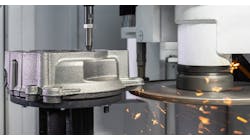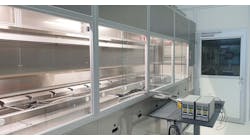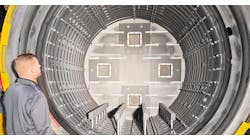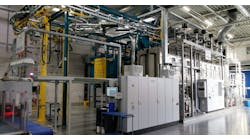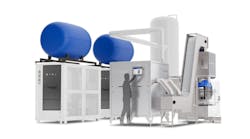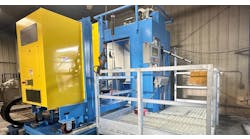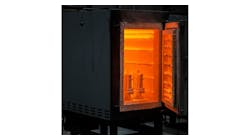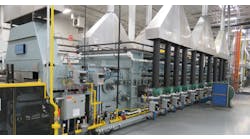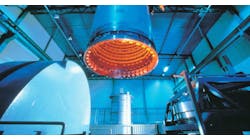Heat Treater Adds Capacity, Flexibility
CO2 Recovery for Dry Ice Production
New Machine Speeds Ceramic Shell Cleaning
Quiz: What Do You Know About Heat Treating?
Can-Eng Doubling Production Space
Castings often are used in applications with aggressive conditions and require specific performance at their surfaces, such as excellent corrosion-resistance and high levels of wear-resistance, and so coatings often are applied to modify surface properties. Both organic (paints, polymers) and inorganic (electro-plating, conversion coatings, and galvanizing) coatings are applied to castings, but many of these types of coatings suffer from problems that severely constrain their applications, including limitations for high-temperature use or lack of wear resistance. When a combination of wear-, corrosion-, and higher-temperature resistance is required, coating processes such as electroplating and electroless plating are used, but those coatings often face environmental problems associated with the coatings themselves. Frequently, it may be difficult to find the perfect balance of wear- and corrosion-resistance among the many coating technologies available.
Another class of hard-surface coatings that provide excellent wear-resistance are produced by Physical Vapor Deposition (PVD.) These types of coatings are commonly used for coating machine tools, and as they provide excellent wear- and abrasion-resistance also are used in many other applications, including automotive parts, engines, and machines.
Typically, PVD coatings are based on metal nitrides, carbides, and oxides, and commonly used PVD coatings include TiN, CrN, TiAlN and AlCrN. One PVD coating method, frequently applied to achieve wear-resistance is the Cathodic Arc Process, and as coatings produced by this process are chemically inert they also should provide excellent corrosion protection.
However numerous studies have shown that the corrosion protection of most PVD coatings is relatively poor. The reason for this is the defects present in the coating structure, such as macro-particles, flakes, and porous microstructures (Figure 1a), which allow corrosive media to pass through the PVD coating to reach the base metal below.
An improved PVD process is available from Phygen Coatings that contains a seal that contains a significantly lower level of macro-particles and other defects (Figure 1b), and thus provides significantly better corrosion protection that conventional PVD coatings. This modified Cathodic Arc PVD process is called Arc Plasma Acceleration (APA.) A cross-section through a coating produced by the APA process shows the low defect-content and the dense nature of the coating (Figure 2a), which prevents corrosive media from passing through the coating and reaching the base metallic substrate.
A quantitative comparison of the characteristics of the macro-particles in Phygen’s APA coatings compared with typical PVD coatings is summarized in Table 1. This shows that both the number and size of the macro-particles in Phygen’s APA coatings are significantly smaller than typical PVD coatings, and the low defect structure and dense nature of the coatings are the reasons for the excellent corrosion-resistance of coatings produced by the APA process.
Both PVD coating and the Arc Plasma Acceleration (APA) processes were detailed2 previously, and so only be briefly summarized here. The PVD process consists of evaporating metallic atoms from a target of the desired composition, and these atoms travel across the deposition chamber, where they react with low concentrations of gasses (nitrogen, hydrocarbons, or oxygen) as they deposit onto the substrate of interest.
The APA is a modified cathodic arc PVD process using a magnetic field generator that creates a magnetic field with a distinctive cusp shape, which provides enhanced trapping of the plasma particles generated from the cathodic source.
The APA process permits control over the growth of the coating, both via the intensity of ion bombardment (through the plasma density control) and the energy of arriving particles (through the substrate bias potential.) A key to the process is to ensure that a large number of ions are bombarding the surface with a velocity in a specific range, and by tuning that range, crystalline configurations with weaker bonding can be minimized while preserving the strongest bonds. This results in growth of a dense and highly textured coating, having a low defect content, and an excellent metallurgical bond to the substrate (Figure 2a.)
Engineers and scientists at the U.S. Army Armament Research and Development Center at the Benet Laboratories and Picatinny Arsenal recently compared the characteristics of Phygen’s coatings produced by the APA process with common, “off-the-shelf” hard metal-plated coatings, such as electroplated Cr and electroless-plated Ni. The comparisons included hardness of the coatings, wear resistance, coefficient of friction, and corrosion-resistance. Before describing the results of their study, however, it is worthwhile to briefly describe the range of PVD coatings available from Phygen.
Phygen PVD coatings — Table 2 lists the various PVD coatings available from Phygen. The “plus” designation indicates that the coating structure includes an intermediate ion-nitrided layer, which can harden the surface layer in a ferrous alloy substrate and help support the PVD coating. The duplex CrN/DLC and CrN/SiC are relatively new coatings that exhibit lubricious surface characteristics, allowing them to be used in applications that require solid lubrication. Photomicrographs showing sections through these bi-layer coatings are presented in Figures 2b and 2c, showing that these duplex compositions also produce extremely dense coatings.
Characteristics of the coatings — Following here are descriptions of various beneficial characteristics of the coatings produced using the APA process. As noted, the measurements were performed at the U.S. Army Armament Research and Development Center at the Benet Laboratories and at Picatinny Arsenal1.
Hardness. It is well known that the PVD process produces coatings with extremely high values of hardness. The hardness values measured by the Army scientists are shown in Table 3, and the measured values for the PVD coatings compare well with data published by Phygen in Table 2, and are significantly higher than plated coatings, such as Ni-P and Cr. For comparison, a steel with a hardness of 40 Rockwell C converts to 3.8 GPa in the SI system, a factor of 5-8 times lower than the hardness of the PVD coatings.
Wear resistance. The high values of hardness for the PVD coatings result in high levels of wear resistance (Table 4.) Wear rates were measured using the pin-on-disk technique. The measured wear rates for the PVD coatings were about 3.5 times better than electroless Ni-P, and nearly 40 times better than the electroplated chromium.
Coefficient-of-friction measurements. Average steady-state coefficient-of-friction (CoF) values also were obtained from pin-on-disk measurements (Table 5.) Interestingly, the CoF values for the CrN/DLC and the CrN/SiC duplex PVD coatings were significantly lower than the other coatings tested, suggesting that these duplex coatings also could be beneficial in applications requiring solid lubrication.
Corrosion protection. The Army scientists also performed a comparison of the corrosion protection of Phygen’s APA-processed CrN and CrN/SiC coatings versus electroplated chromium (12 mm and 40 mm thick), electroless high-phosphorous nickel (40 mm thick), and a conventional cathodic arc CrN coating. Corrosion testing was performed in accordance with the GM9540P specification, which involved 30 cycles of 16-hour exposure to chloride solutions at 49oC, and the results reproduced in Figure 3 show that the CrN and CrN/SiC coatings produced by the APA process exhibited significantly better corrosion-resistance than the conventional PVD-processed CrN, or the electroplated chromium, and equivalent corrosion-resistance to a 40 mm thick electroless high-phosphorous nickel plate. This confirms that the low-defect structure present in PVD coatings produced using the APA process does indeed provide excellent corrosion resistance, equivalent to electroless nickel.
Coatings produced by Phygen’s APA process can provide an interesting combination of properties, including excellent hardness, wear-resistance and corrosion-protection. Based on the results of the testing described here, the U.S. Army selected Phygen’s CrN coating to replace the chromium coating applied to breech spindles for howitzers. The problem being addressed was that wear and corrosion required premature replacement of the chromium-coated spindles well before the end of their useful life. Officials at Picatinny Arsenal have estimated that the replacement of chromium with the CrN coating will result in a $5 million savings over the life of the M777A2 howitzer.
David Bell is the president/CEO and Viktor Khominich is the chief of technology development, and both are with Phygen Coatings Inc.
Steve Midson is the principal of The Midson Group, a metallurgical consulting agency.
REFERENCES
1. C.P. Mulligan, M. Senick, D.P. Schmidt, V. Khominich, Z. Gay and D. Bell, “CrN, CrN/SiC and CrN/DLC Coatings Deposited by a Novel Arc Plasma Acceleration Process: Processing and Properties”, Materials and Manufacturing Processes 29 (2014): p 1037
2. David Bell, Viktor Khominich and Steve Midson, Using PVD Coatings to Reduce Diecasting Costs, Foundry Management & Technology, Feb. 2020, p16.
